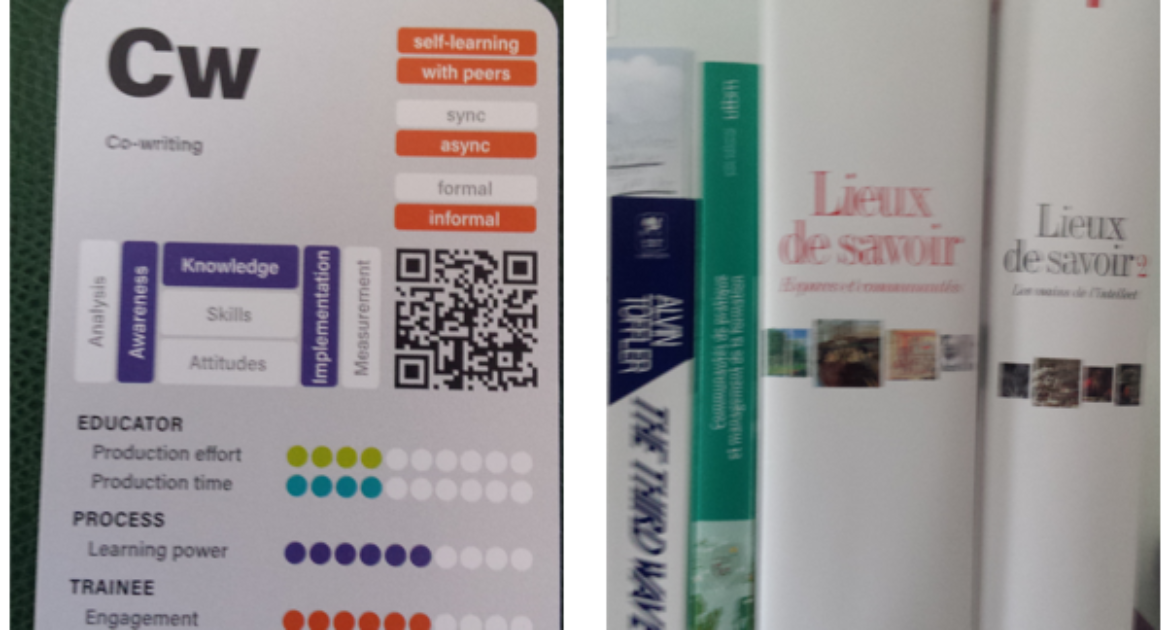Cw – La carte de l’écriture collaborative (#LBC)

Cw – Co-writing (#LBC)
Mon point de vue
Cette nouvelle carte est elle aussi à prendre comme déclencheur de la réflexion. Comment faire du co-writing, que je traduirais par écriture collaborative, un élément clé d’un dispositif de formation ?
Pour moi, le préalable est de définir l’ampleur du projet, que veut-on co-écrire et en combien de temps ? L’histoire du monde de la perspective des 5 continents, projet sur 10 ans avec 3000 participants, ou bien, dans le temps d’une séance de cours de deux heures sur les formes de poèmes japonais, écrire à quatre mains un renga (1).
Je vois très bien cette carte associée à d’autre cartes comme le World Café (Wf) ou la Communauté de pratique (Cp – Community of practice)
Références
* Le renga (連歌?, « poésie en collaboration ») est un genre de la poésie japonaise collaborative . Un renga comprend au moins deux ku (句?) ou strophes. La première strophe d’un renga, appelée le hokku (発句?), est devenue la base de la forme de poésie moderne haiku. (source : Wikipedia)
Voici le début d’un Renga écrit avec T (une dame japonaise) sur une période de 2 ans
Les pommes sont tombées,
Une abeille m’a piqué :
Souvenir d’enfance.
O honeybees buz and fuss
Like daddies of foregone days.
**
Summer days are gone
Snow covers the fields and trees
Where the bee was seen
The snowfield bright and intact
Silent but a naughty fox
**
Cw – Co-writing (#LBC)
My point of view
This new card should also be taken as a trigger for reflection. How to make co-writing, which I would translate as collaborative writing, a key element of a training system ?
For me, the prerequisite is to define the scope of the project, what do we want to co-write and in how long? The history of the world from the perspective of the 5 continents, a 10-year project with 3,000 participants, or, in the time of a two-hour class on Japanese poem forms, writing a Renga (1) with four hands.
I can see this card being associated with other cards such as the World Café (Wf) or the Community of practice (Cp)
References
(1) Renga (連歌?, « collaborative poetry ») is a genre of Japanese collaborative poetry. A renga consists of at least two ku (句?) or stanzas. The first stanza of a renga, called the hokku (発句?), became the basis for the modern poetry form haiku (source: Wikipedia).
Here is the beginning of a renga written with T (a Japanese lady) over a period of 2 years
The apples have fallen,
A bee stung me:
Childhood memory.
O honeybees buz and fuss
Like daddies of foregone days.
**
Summer days are gone
Snow covers the fields and trees
Where the bee was seen
The snowfield bright and intact
Silent but a naughty fox
******
Cw – Co-writing (#LBC)
Mein Standpunkt
Auch diese neue Karte ist als Auslöser für Überlegungen zu verstehen. Wie kann man das Co-Writing, das ich als kollaboratives Schreiben bezeichnen würde, zu einem Schlüsselelement eines Bildungsangebots machen?
Für mich besteht die Vorbedingung darin, den Umfang des Projekts zu definieren, was will man gemeinsam schreiben und in welcher Zeit? Die Weltgeschichte aus der Perspektive der fünf Kontinente, ein Projekt über zehn Jahre mit 3000 Teilnehmern, oder in der Zeit einer zweistündigen Unterrichtseinheit über japanische Gedichtformen vierhändig ein Renga (1) schreiben?
Ich kann mir diese Karte sehr gut in Verbindung mit anderen Karten wie World Café (Wf) oder Community of practice (Cp – Gemeinschaft der Praxis) vorstellen.
Referenzen
(1) Renga (連歌?, « kollaborative Poesie ») ist eine Gattung der kollaborativen japanischen Poesie. Ein Renga besteht aus mindestens zwei Ku (句?) oder Strophen. Die erste Strophe eines Rengas, das sogenannte Hokku (発句?), wurde zur Grundlage der modernen Gedichtform Haiku. (Quelle: Wikipedia).
Hier ist der Anfang eines Renga, das mit T (einer japanischen Dame) über einen Zeitraum von zwei Jahren geschrieben wurde.
Die Äpfel sind heruntergefallen,
Eine Biene hat mich gestochen :
Kindheitserinnerung.
O honeybees buz and fuss
Like daddies of foregone days.
**
Die Sommertage sind vorbei
Schnee bedeckt die Felder und Bäume.
Wo die Biene gesehen wurde
Das Schneefeld hell und unberührt
Still nur ein kindlicher Fuchs
Related Posts
Learning Coach – Le précepteur du 21e Siècle ? 5/n
Théories et pratiques de l’apprentissage situé 53/101
Codéveloppement à haute vitesse 6/n
Articles récents
Archives
- mars 2024
- janvier 2024
- décembre 2023
- septembre 2023
- juin 2023
- avril 2023
- mars 2023
- janvier 2023
- octobre 2022
- septembre 2022
- juillet 2022
- mai 2022
- avril 2022
- mars 2022
- février 2022
- janvier 2022
- octobre 2021
- août 2021
- juillet 2021
- mai 2021
- février 2021
- juin 2020
- mai 2020
- avril 2020
- février 2020
- janvier 2020
- décembre 2019
- novembre 2019
- octobre 2019
- septembre 2019
- août 2019
- juillet 2019
- mai 2019
- avril 2019
- mars 2019
- février 2019
- janvier 2019
- décembre 2018
- septembre 2018
- août 2018
- juillet 2018
- juin 2018
- mai 2018
- avril 2018
- mars 2018
- février 2018
- janvier 2018
- décembre 2017
- novembre 2017
- octobre 2017
- septembre 2017
- août 2017
- juin 2017
- mai 2017
- avril 2017
- mars 2017
- février 2017
- janvier 2017
Catégories
- Actualités
- Adaptive Learning
- Allemagne
- Apprendre
- Apprentissage
- Branding
- Business
- Coaching
- Codeveloppement
- Communautés de pratique
- Deep learning
- Design
- Development
- E-Learning
- Ecole
- Education
- Europe
- Formation
- IA
- Intelligence articificielle
- LBC
- metacognition
- Non classé
- Orientation
- orientation
- Philosophie
- Poésie
- Réalité Augmentée
- Réalité Virtuelle
- Transition digitale
- WOL





Commentaires récents